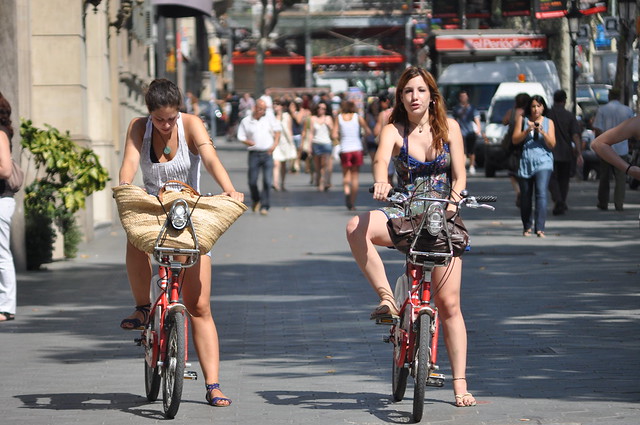
(Photo: Pointing where I think the route goes on Falled on Account of Strain, pitch two (5.10b).)
Another late-season climbing day, another chance to push the limits.
I had big ideas as Adrian and I headed to the Gunks. I knew Adrian wanted to lead WASP (5.9), which I led earlier this year. WASP sits down at the Slime Wall, near the far end of the Trapps. I've spent very little time down there, so there were a bunch of climbs I was interested in checking out. One of the top climbs on my list was Falled on Account of Strain. The first pitch, which ends at a set of bolts, is rated 5.9. The second pitch goes at 5.10b through an incredible set of gigantic, tiered roofs.
As insane as it might sound, I was thinking I would lead the second pitch. I'd seen pictures of the route; the roofs pulled at me like a magnet. The thought of climbing them had me slobbering with Pavlovian anticipation.
But first we did WASP, and I have to say I wasn't exactly feeling super strong. Following pitch one I found the early moves surprisingly difficult. I caught myself thinking I wasn't sure how I'd feel leading the route, and then remembered that I'd led it a few months ago! I had thought I might try to lead the 5.9 variation climb Stubai to You as our second pitch, but when we got up to the GT Ledge I decided, given that I felt a little tentative, to check out Sticky Gate Direct (5.7) instead. (It was good! A very nice pitch, better than pitch two of WASP.)
Back on the ground, we walked over to Falled on Account of Strain and had a look. I thought we should go for it. Adrian was totally up for the first pitch, and since it ends at bolts we could easily bail from there. I figured I could venture out to look at the roofs and come back if it seemed too hairy. Also Dick Williams suggests as an alternative the second pitch of Tomorrow and Tomorrow and Tomorrow, which goes through the roofs at an easier 5.8 grade. Dick gives Tomorrow x 3 no stars, but I guessed it would still be an interesting alternative, and maybe from the shared rap station we could lower ourselves over Falled and try the crux if it was too scary on lead.

(Photo: Early in the 5.9 pitch one of Falled on Account of Strain.)
We got set up beneath Falled and before getting started I wandered into the woods to take a quick leak. As I stood there amongst the trees I jokingly called over to Adrian "you're on belay, climb when ready!"
"Are you going to belay me," he replied, "or are you just going to stand there with your dick in your hand?"
Maybe you just had to be there, but this became a source of much hilarity for us. "Or are you just going to stand there with your dick in your hand" can be usefully adapted to fit into just about any climbing conversation.
For example:
"So go ahead and give me the rack, whenever you're done standing there with your dick in your hand."
Or:
"I just took this amazing photo of you, while I was holding the rope AND standing here with my dick in my hand."
And so on.
I guess you had to be there.
Anyway, pitch one of Falled on Acoount of Strain turned out to be a very worthwhile climb in its own right. Dick rates it at 5.9 but Swain calls it a 5.9+ and I think Swain has it right. The first moves are 5.6-ish but unprotected, up the face to the left of a thin seam. Once you get some pro in, about 15 feet up, you move to the right and into the crux, thin moves between spaced horizontals. The first of these moves puts your feet even with your last protective gear. Your next pro comes in a blind placement over your head at the next horizontal. Adrian is much taller than me and he had to do a pull up to examine the gear and fix it before making the next moves. Following him, I found that I had to step up fully into the move to examine the gear and get it out. I had to struggle a bit with the piece and I almost popped off while trying to remove it.
Dealing with this one difficult placement is my only real concern about eventually leading this pitch. Afterwards the climbing and the gear get easier to handle.

(Photo: Almost done with pitch one of Falled on Account of Strain. The tiered roofs await, overhead. The pitch one crux comes between the two horizontals visible in the lower right corner of the photograph.)
When I joined Adrian at the belay he asked me if I was really up for leading pitch two. Looking out at the roofs I thought it seemed simple enough to wander over and check them out. I was sure I could get gear in the first tier of the roof system. So long as I could get pro at each tier, I figured, I could keep moving up. There would be no shame in taking a hang, as long as the gear was good and the falls were clean.
And so I ventured forth, promising not to make any moves I couldn't reverse until I was sure about continuing.

(Photo: The point of no return. To continue, or not?)
I traversed easily to the first overhang. There was good gear. I believed I was at the right spot at which to pull up and over to the next tier. There was a lot of chalk even further right, but it seemed to me this was errant chalk, sucker chalk.
I pulled up enough to see if I could get gear at the next tier. I couldn't see any potential placements. This was a major bummer.
What about further right? I ventured over to the sucker chalk and looked up there. But I didn't see any gear over there either.
I wandered back to where I thought the route really went and kept looking it over. I felt a rush of emotions and excitement. I had a decision to make.
Option A: I could commit to the next tier, knowing I would have to move up AGAIN to the final tier before finding any pro. There had to be gear up there, or this thing wouldn't be rated PG, right? But if I committed to this course I doubted I could climb back down and if I popped off it would be a real fall.
Option B: I could give up and traverse back to the anchor.
I hope this doesn't sound too grandiose, but I felt I stood at a sort of crossroads.
I was straddling a line dividing my climbing past and my hoped-for climbing future. A past mired in moderates, and a future involving the real deal. A past of mucking about on ledges, and a future filled with improbable environments and thrilling situations. A past of standing around with my dick in my hand, and a future of bold action.
The atmosphere beneath the overhang was incredible. I wanted to go for it, but I wasn't quite sure I was ready. It had been a great year. Maybe this climb was meant for next year?
Adrian called over to give his opinion.
"You want me to support you, right?"
"No, dude, tell me what you really think."
"It looks crazy to me."
That was all I needed to hear. I decided to traverse back to the anchor and climb Tomorrow x 3 instead.

(Photo: Getting into the 5.8 roof on Tomorrow and Tomorrow and Tomorrow.)
I'm glad we went ahead and did Tomorrow x 3, because the roof was fun. It is not a cakewalk by any means. The holds are very good, but once you are in the roof you traverse out to the left (with good pro) and it is very strenuous, a little burly, I think, for 5.8.
I later learned that Swain calls this a 5.10 roof, so I could claim this as my second 5.10 Gunks lead... but let's get real. There's no way this is a 5.10. Maybe 5.8+ or 5.9-.
Once you get above the roof, the remaining climbing up and right to the Falled anchor is very dirty/bushy, and not very pleasant. And the fixed station for Falled as of this writing is crap. There is a big old angle piton (rusty but probably fine), three nested rusty pitons (impossible to evaluate), and two equalized nuts in a horizontal, at least one of which has a cable that is almost rusted out. All of it is tied together with ancient, faded, stiff cord and webbing.
I refused to use this anchor. If you go up there, bring some cord/webbing and maybe some nuts to shore up the station. We ended up bushwhacking through filthy territory to the GT Ledge and then we rapped off the Sticky Gate tree, which will get you down with a single 70 meter or with 60 meter doubles.
Adrian later asked me why I am so attracted to these roof problems. I gave him the cold, logical reason: I'm looking for good holds and clean falls. Face climbs of the same grade tend to involve more difficult sequences and more fiddly gear. He responded quite reasonably that he prefers the face climbs because you can stop and think before the crux, whereas with the roofs you know the clock is always ticking. He felt more secure on the 5.9+ face of Falled, for example, than he did in the 5.8 roof on Tomorrow x 3, because on Falled he knew he could chew over the moves as long as he liked before making the commitment.
This is of course a matter of personal preference, with no right answer. What I failed to add to my side of the argument, but what still tips the balance for me, is that the roofs are awesome. To me there's no thrill like getting over a big roof. I guess that's just what makes me a Gunks guy. Looking at the roof photos above, I find it hard to imagine feeling any other way.


 My bicycles are not exactly run-of-the-mill, and they tend to get noticed when I am out and about. But nothing has compared to the effect of installing these dress guards on Marianne. Without exaggeration, the dress guards draw crowds of women, their eyes full of wonder at the sight of these unique creations. Subtle they are not. But they are sure to brighten up your day. I received these dress guards as part of an equal value exchange fromSimeli
My bicycles are not exactly run-of-the-mill, and they tend to get noticed when I am out and about. But nothing has compared to the effect of installing these dress guards on Marianne. Without exaggeration, the dress guards draw crowds of women, their eyes full of wonder at the sight of these unique creations. Subtle they are not. But they are sure to brighten up your day. I received these dress guards as part of an equal value exchange fromSimeli First I must say that I've had the dress guards for some time now, but could not find a bike on which to install them. I was initially hoping to fit them on a loop frame bicycle, but all of mine already had dress guards and removing them would have been a pain. Finally I installed them on my mixte, and the combination is unexpectedly fabulous.
First I must say that I've had the dress guards for some time now, but could not find a bike on which to install them. I was initially hoping to fit them on a loop frame bicycle, but all of mine already had dress guards and removing them would have been a pain. Finally I installed them on my mixte, and the combination is unexpectedly fabulous.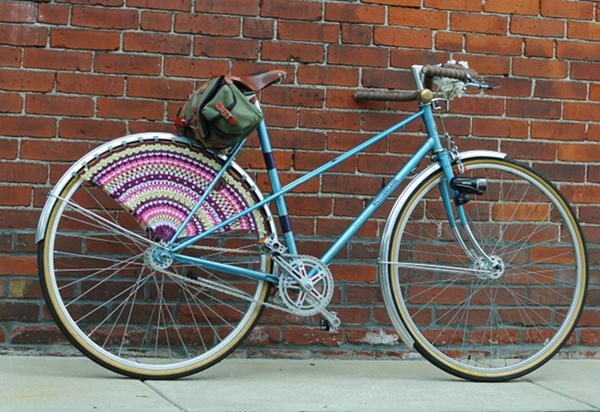 Here is a straight-up view. It is not as typical to install dress guards on a mixte as it is on step-through bicycles, but I really do not see why not. It was done in the past, and in Europe you will find many older mixte bicycles with holes drilled into the fender - evidence that at some point the dress guards were there. If you use your mixte for transportation and you wear fluttery skirts or coats, this is a useful accessory.
Here is a straight-up view. It is not as typical to install dress guards on a mixte as it is on step-through bicycles, but I really do not see why not. It was done in the past, and in Europe you will find many older mixte bicycles with holes drilled into the fender - evidence that at some point the dress guards were there. If you use your mixte for transportation and you wear fluttery skirts or coats, this is a useful accessory.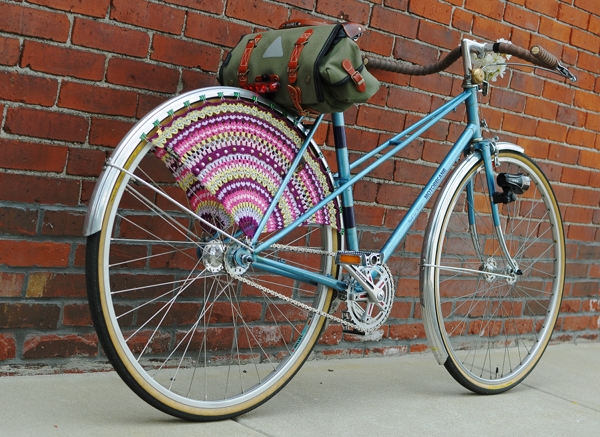 This angle gives you an idea of how the dress guards are attached: They connect to the bolts (or the fender stays) at the rear dropouts and to the fenders via clips.The clips are supplied by Simeli along with the dress guards, and are available in a variety of colours. If your fenders are deep enough to fit the clips without rubbing the wheel, you do not need to drill holes. However, please note that the attachment system was designed for the sort of wide, deep fenders that are found on Dutch bikes, English roadsters, and similar bicycles. If you have fenders like the ones pictured on my mixte, the clips will likely rub the tire. We have angled the clips on my bike as best as we could, and they still rub a bit. So if I keep this set-up in the long run, I will drill the fender and re-install the dress guards that way.
This angle gives you an idea of how the dress guards are attached: They connect to the bolts (or the fender stays) at the rear dropouts and to the fenders via clips.The clips are supplied by Simeli along with the dress guards, and are available in a variety of colours. If your fenders are deep enough to fit the clips without rubbing the wheel, you do not need to drill holes. However, please note that the attachment system was designed for the sort of wide, deep fenders that are found on Dutch bikes, English roadsters, and similar bicycles. If you have fenders like the ones pictured on my mixte, the clips will likely rub the tire. We have angled the clips on my bike as best as we could, and they still rub a bit. So if I keep this set-up in the long run, I will drill the fender and re-install the dress guards that way.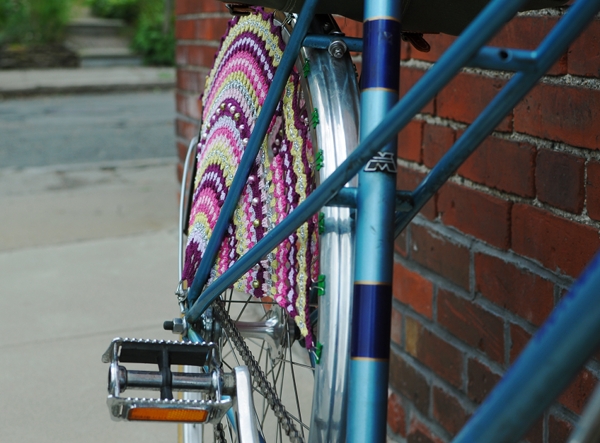 Simeli dress guards were designed to work with either 28" or 26" wheels, so anything in between is fine as well. This includes 650B, 27"and 700C wheels. The wheels on my bicycle here are 27" and the dress guards stretch tightly.
Simeli dress guards were designed to work with either 28" or 26" wheels, so anything in between is fine as well. This includes 650B, 27"and 700C wheels. The wheels on my bicycle here are 27" and the dress guards stretch tightly. 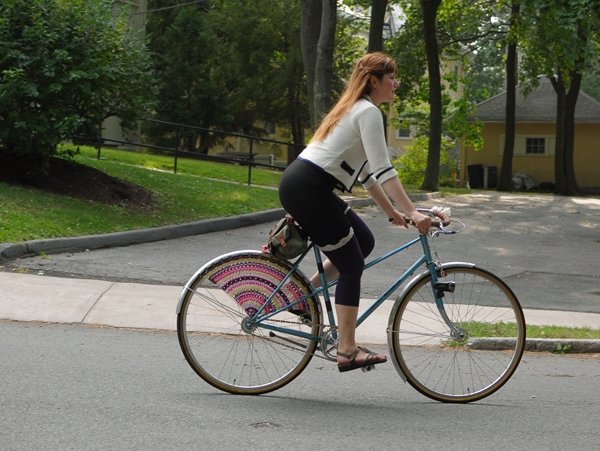 Another thing to note is that - like most dress guards - these have an opening to fit over either a "cafe lock" or a caliper brake on the rear wheel (click to enlarge the picture to see the opening). The opening is aligned with the rear stays, so even if you have neither a lock nor a caliper brake on the rear wheel, it is unobtrusive.
Another thing to note is that - like most dress guards - these have an opening to fit over either a "cafe lock" or a caliper brake on the rear wheel (click to enlarge the picture to see the opening). The opening is aligned with the rear stays, so even if you have neither a lock nor a caliper brake on the rear wheel, it is unobtrusive. As far as performance goes, these dress guards certainly do their job. They cover a large portion of the wheel and are densely knit. Any outfit you could wear is safe from the spokes with these installed. They do not shift or flutter or make any noise (other than the potential problem of the clips rubbing narrow fenders), and they hold up securely.
As far as performance goes, these dress guards certainly do their job. They cover a large portion of the wheel and are densely knit. Any outfit you could wear is safe from the spokes with these installed. They do not shift or flutter or make any noise (other than the potential problem of the clips rubbing narrow fenders), and they hold up securely.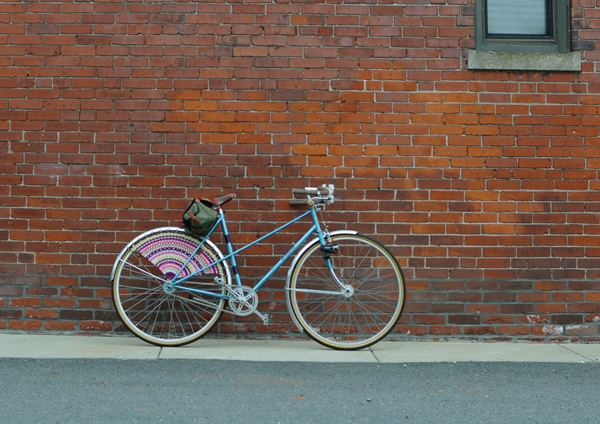 Of course the singlemost feature one is drawn to when discussing these, is the looks. There are several models offered by Simeli, and all of them feature crochet work in bright, cheerful colours. Mine are pink, lilac and light green, with silvery thread and a row of peralescent beads woven in between (the model is Linde).
Of course the singlemost feature one is drawn to when discussing these, is the looks. There are several models offered by Simeli, and all of them feature crochet work in bright, cheerful colours. Mine are pink, lilac and light green, with silvery thread and a row of peralescent beads woven in between (the model is Linde). Here is a close-up of the colours and the row of beads. If you've been reading this blog, you know that I do not tend to go for colourful designs like this, and instead gravitate towards neutral colour palettes. But it's nice to try new things once in a while, and hey - it's summer after all!
Here is a close-up of the colours and the row of beads. If you've been reading this blog, you know that I do not tend to go for colourful designs like this, and instead gravitate towards neutral colour palettes. But it's nice to try new things once in a while, and hey - it's summer after all!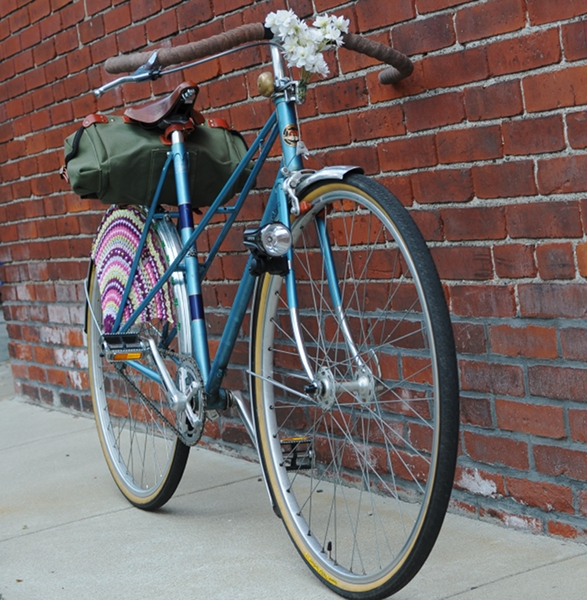 The shimmery aqua-blue of Marianne's frame is too much for me as it is, so I decided to go all out and make her my "technicolor dream coat" bicycle. And that she is!
The shimmery aqua-blue of Marianne's frame is too much for me as it is, so I decided to go all out and make her my "technicolor dream coat" bicycle. And that she is! But the crucial question: Would I buy these dress guards if they were not sent to me for review? I would if they were available in an off-white or natural-hemp sort of colour, or even something silvery or gold-ish. In fact, I am looking for something like that for the new custom mixte we are building up and would even gladly drill the fenders if they prove too tight for the clips. The bright and cheerful colours on the models currently available are not my style - but given the response they get out in the streets, I believe I am in the minority in that respect.
But the crucial question: Would I buy these dress guards if they were not sent to me for review? I would if they were available in an off-white or natural-hemp sort of colour, or even something silvery or gold-ish. In fact, I am looking for something like that for the new custom mixte we are building up and would even gladly drill the fenders if they prove too tight for the clips. The bright and cheerful colours on the models currently available are not my style - but given the response they get out in the streets, I believe I am in the minority in that respect.



